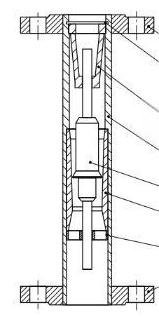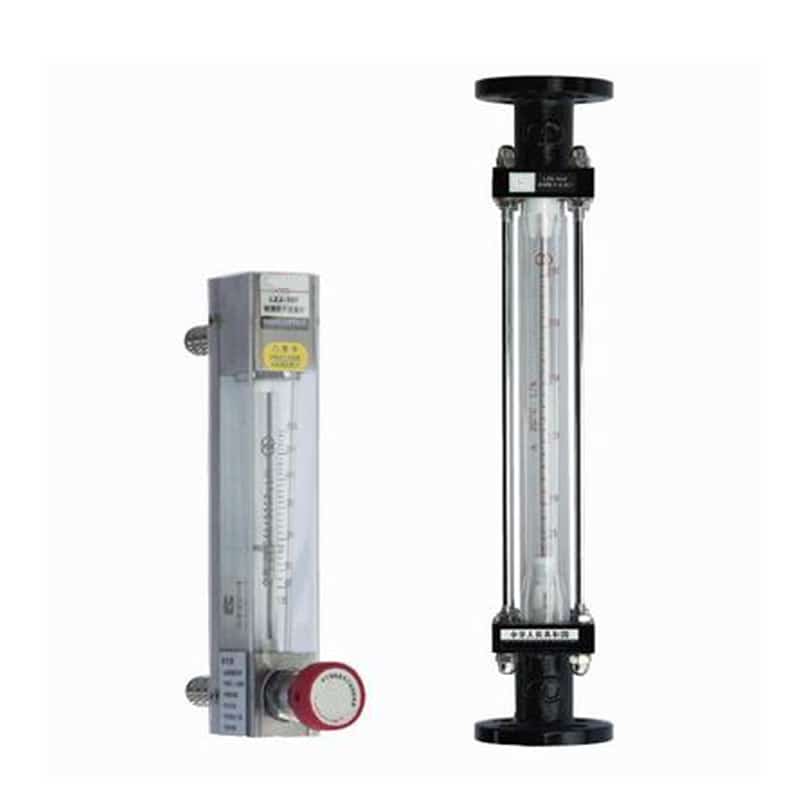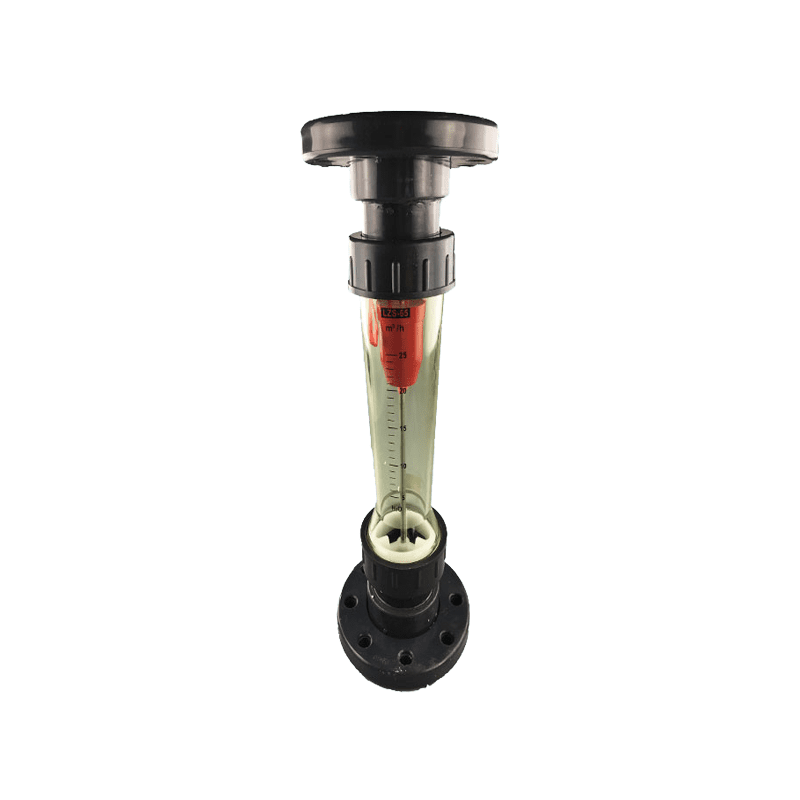In modern industry, accurate flow measurement is the key to ensuring productivity and product quality. Whether in the chemical, pharmaceutical, food and beverage, or water treatment industries, variable area flowmeters have become a common choice for flow measurement due to their simple and reliable design, wide applicability and affordability.
What Is A Variable Area Flow Meter?
A Variable Area Flow Meter is an instrument commonly used to measure fluid flow. Designed with glass or plastic tubes, it allows for direct observation of the medium’s flow. Rotameters are a popular choice for simple yet accurate flow measurement tasks. They are particularly well-suited for applications that require low maintenance and easy-to-read measurements. Rotameters and variable area flow meters are essentially the same type of flow meter, with “rotameter” being a specific application or a common term for a variable area flow meter.
Features
- The float position is proportional to the flow rate: As the fluid flow increases, the float rises higher, making the flow reading very intuitive.
- No external power required: This type of flow meter typically does not need a power supply or other external energy sources; it is a mechanical device.
- Suitable for various fluids: It can be used with liquids, gases, and steam.
- Common in industrial applications: It is frequently used in industries such as oil and gas, chemical, pharmaceutical, and food and beverage for process flow monitoring.
Main Applications
- Flow monitoring for liquid chemicals
- Water treatment and environmental industry
- Pharmaceutical industry
- Food and beverage industry
- High pressure flow on offshore oil platforms
- Chemical injection
- Cleaning liquid or gas metering
Working Principle of Variable Area Flow Meter
It operates based on the principle that as fluid flows through a vertically oriented tapered tube, it pushes a float up or down. The position of the float changes with the flow rate, allowing the flow to be measured.
- Relationship between float position and flow rate: As the fluid flows, it pushes the float upward. However, because the cross-sectional area of the tapered tube increases, the fluid velocity decreases. The float will stop rising at a balance point, which depends on the flow rate and the weight of the float. When the flow rate increases, the float rises higher; when it decreases, the float drops.
- Reading display: The height of the float represents the fluid flow rate, so the flow meter’s scale is typically marked along the tapered tube. The reading can be obtained by directly observing the float’s position. Some flow meters are also equipped with a pointer or digital display to provide a more precise reading of the flow rate.

Types of Variable Area Flowmeters
- Glass Tube Variable Area Flow Meter
The glass tube design allows for easy observation of the float’s position, making it ideal for laboratory settings or applications requiring real-time flow monitoring. APURE’s LZB glass tube rotameter is suitable for real-time monitoring applications. - Metal Tube Variable Area Flow Meter
With a metal tube replacing the glass tube, this flow meter is more durable and suitable for measuring flow rates in high-temperature, high-pressure, and corrosive environments. It is widely used in industries such as chemicals, oil and gas, and pharmaceuticals, especially under harsh operating conditions. APURE’s LZD metal tube rotameter is ideal for industrial applications. - LZS Rotameter
The LZS rotameter is a common type of variable area flow meter, typically used for general industrial flow measurement. It is suitable for measuring various liquids and gases.



Why Are They Used To Measure Gas Or Liquid Flow?
1. Simple Structure and Easy to Use
The design of the variable area flow meter is very simple, primarily consisting of a vertical conical tube and a float, without any complex mechanical or electronic components.
2. Wide Range of Applications
It is very effective in measuring low to medium flow rates and can be used with corrosive gases, clean liquids, or fluids containing suspended particles.
3. High Reliability and Durability
Due to the absence of moving mechanical parts, variable area flow meters are highly reliable and durable. They can operate stably in harsh industrial environments over long periods and have low maintenance costs.
4. Intuitive Reading Display
The height of the float is proportional to the flow rate, allowing operators to directly observe the float’s position to read the flow rate.
5. No External Power Required
Variable area flow meters are entirely mechanical and do not require any external power source or complex sensors. They are particularly suitable for applications where power supply is inconvenient or where independent local measurements are necessary.
6. Capable of Handling Various Conditions
Variable area flow meters can adapt to different operating conditions, including low pressure, high pressure, and corrosive media. In many industrial applications, they can handle varying fluid characteristics and operating conditions, providing stable flow measurements.
7. No Straight Pipe Section Required and Suitable for Low Flow Rates
Unlike some flow meters that require long straight pipe sections to ensure measurement accuracy, variable area flow meters have low requirements for straight pipe sections. They are susceptible to low flow rates, and able to accurately measure low flow rates of gases and liquids.
How to Choose A Variable Area Flow Meter?
Fluid Type
- Liquid or gas: Determine whether you need to measure liquid or gas, as different fluid types will influence the design choice of the flow meter.
- Corrosiveness: If you are measuring corrosive fluids, you need to consider corrosion-resistant materials such as stainless steel, and PTFE lining.
- Viscosity: The viscosity of the fluid affects the selection of the flow meter; highly viscous liquids may require specially designed flow meters to ensure accurate measurement.
Flow Range
- Minimum and maximum flow: Determine the minimum and maximum flow rates of your system to select the appropriate flow meter model. Ensure that the meter’s range covers your operating conditions and can provide accurate readings even at the minimum flow rate.
- Flow velocity: The velocity of the fluid also affects the stability of the float and the accuracy of the readings, so make sure the selected flow meter is suitable for your flow velocity range.
Operating Pressure and Temperature
- Pressure: Determine the operating pressure of your system; the flow meter needs to withstand the maximum operating pressure without deformation or damage.
- Temperature: The flow meter must be able to operate within the temperature range of your system. High or low temperatures may require the use of special materials or a specifically designed flow meter.
Accuracy Requirements
- Measurement accuracy: Choose the appropriate accuracy level based on your application needs. Industrial process control usually requires high accuracy, while some rough measurement scenarios may allow for lower accuracy.
- Linearity: Some applications may require the flow meter to maintain linear output across the entire range to facilitate easier data processing and analysis.
Material Selection
- Float and tapered tube materials: Select the appropriate materials for the float and tube based on the chemical properties of the fluid, such as stainless steel, glass, aluminum, or engineering plastics.
- Sealing materials: Ensure that the sealing materials are compatible with the fluid to prevent leaks or corrosion issues.
Maintenance and Calibration
- Ease of maintenance: Choose a flow meter that is easy to maintain and clean, especially when dealing with viscous or easily fouling fluids.
- Calibration requirements: Understand the calibration cycle and requirements of the flow meter, ensuring that it can be conveniently calibrated and adjusted during operation.
Summary
Apure excels in the field of water quality monitoring. Its advanced sensor technology and sophisticated design provide efficient and accurate water quality testing solutions for various industries. Whether it is for safety testing of drinking water, process control of wastewater treatment, or quality monitoring of industrial water, our products meet a variety of demanding needs with superior performance. In addition to flow meters, our wide range of water quality monitoring sensors can meet your water quality needs on a variety of occasions testing, level measurement, pressure measurement and temperature measurement, and ozone generators for water disinfection, welcome to click on our website to consult with us!
